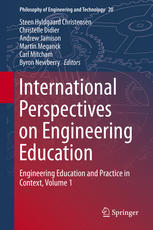

Most ebook files are in PDF format, so you can easily read them using various software such as Foxit Reader or directly on the Google Chrome browser.
Some ebook files are released by publishers in other formats such as .awz, .mobi, .epub, .fb2, etc. You may need to install specific software to read these formats on mobile/PC, such as Calibre.
Please read the tutorial at this link: https://ebookbell.com/faq
We offer FREE conversion to the popular formats you request; however, this may take some time. Therefore, right after payment, please email us, and we will try to provide the service as quickly as possible.
For some exceptional file formats or broken links (if any), please refrain from opening any disputes. Instead, email us first, and we will try to assist within a maximum of 6 hours.
EbookBell Team

4.1
30 reviewsThis inclusive cross-cultural study rethinks the nexus between engineering education and context. In so doing the book offers a reflection on contextual boundaries with an overall boundary crossing ambition and juxtaposes important cases of critical participation within engineering education with sophisticated scholarly reflection on both opportunities and discontents.
Whether and in what way engineering education is or ought to be contextualized or de-contextualized is an object of heated debate among engineering educators. The uniqueness of this study is that this debate is given comprehensive coverage – presenting both instrumentally inclined as well as radical positions on transforming engineering education.
In contextualizing engineering education, this book offers diverse commentary from a range of disciplinary, meta- and interdisciplinary perspectives on how cultural, professional, institutional and educational systems contexts shape histories, structural dynamics, ideologies and challenges as well as new pathways in engineering education. Topics addressed include examining engineering education in countries ranging from India to America, to racial and gender equity in engineering education and incorporating social awareness into the area.
Using context as “bridge” this book confronts engineering education head on. Contending engineering ideologies and corresponding views on context are juxtaposed with contending discourses of reform. The uniqueness of the book is that it brings together scholars from the humanities, the social sciences and engineering from Europe – both East and West – with the United States, China, Brazil, India and Australia.